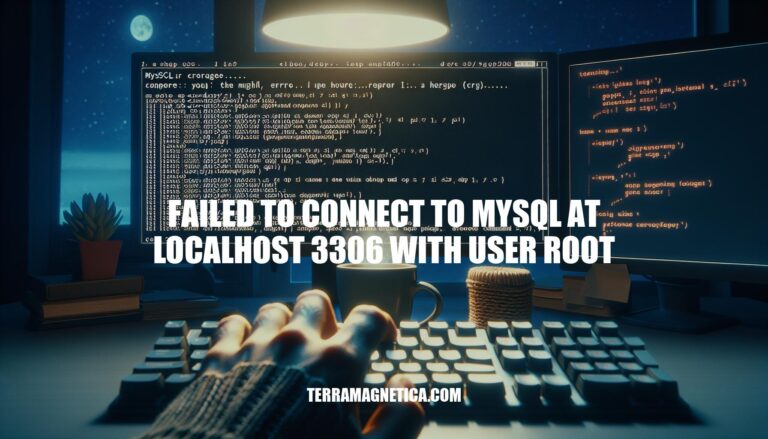


The error message “failed to connect to MySQL at localhost 3306 with user root” is a common issue faced by developers and database administrators. This error signifies that the MySQL client cannot establish a connection to the MySQL server running on the local machine at the default port 3306 using the root user credentials.
This issue can occur due to several reasons:
Understanding and resolving this error is crucial for maintaining database connectivity and ensuring smooth application operations.
Here are the main reasons for the error “failed to connect to MySQL at localhost 3306 with user root”:
Incorrect Credentials: The username or password might be wrong. Ensure you’re using the correct credentials for the root user.
MySQL Server Not Running: The MySQL server might not be running. Check the server status and start it if necessary.
Firewall Issues: A firewall might be blocking the connection. Ensure that port 3306 is open and accessible.
Misconfigured MySQL Server: The server might be misconfigured. For example, the bind-address might be set incorrectly, preventing connections.
Network Issues: There could be network problems preventing the connection. Verify your network settings and try connecting from a different network.
Insufficient User Privileges: The root user might not have the necessary privileges to connect from your address. Check and adjust the user privileges if needed.
Socket Issues: If you’re connecting via a Unix socket, ensure the socket file exists and is accessible.
Port Conflicts: Another service might be using port 3306. Verify that MySQL is configured to use the correct port.
Here are the steps to verify if the MySQL server is running on different operating systems:
Open Services Panel:
Win + R, type services.msc, and press Enter.MySQL in the list of services.Running. If not, right-click and select Start.Command Prompt:
net start MySQL (or net start MySQL80 for MySQL 8.0).Systemd:
sudo systemctl status mysql.Active: active (running).SysVinit:
sudo service mysql status.mysql start/running.Homebrew:
brew services list.started. If not, run: brew services start mysql.Manual Start:
sudo /usr/local/mysql/support-files/mysql.server status.SUCCESS! MySQL running.These steps should help you verify if your MySQL server is running on different operating systems.
Sure, here are the steps to check and correct user credentials for resolving the error ‘failed to connect to MySQL at localhost 3306 with user root’:
Verify MySQL Server is Running:
mysql.server start in the terminal.Check User Credentials:
mysql -u root -p and enter the password when prompted.Reset Root Password:
mysqld_safe --skip-grant-tables &.mysql -u root.ALTER USER 'root'@'localhost' IDENTIFIED BY 'new_password';.Grant Necessary Privileges:
GRANT ALL PRIVILEGES ON *.* TO 'root'@'localhost' WITH GRANT OPTION;
FLUSH PRIVILEGES;
```[^2^][2].
Check Hostname and Port:
localhost) and port (3306).my.cnf or my.ini) for the correct settings.Following these steps should help resolve the connection error.
Firewall settings and network configurations can cause the error “failed to connect to MySQL at localhost 3306 with user root” in several ways:
Firewall Blocking Port 3306: If the firewall is blocking port 3306, MySQL connections will fail. To fix this, you need to allow traffic on port 3306:
sudo ufw allow 3306/tcp and then sudo ufw reload.MySQL Not Listening on Port 3306: Ensure MySQL is configured to listen on port 3306. Check the MySQL configuration file (my.cnf or my.ini) for the following lines:
[mysqld]
port=3306
bind-address=127.0.0.1
Make sure the port is set to 3306 and the bind address is correct.
Network Configuration Issues: If MySQL is configured to ignore network connections or only listen locally, remote connections will fail. Ensure the skip_networking variable is not enabled and the bind_address is set correctly.
Service Not Running: Verify that the MySQL service is running:
services.msc), find MySQL, and start it if it’s not running.sudo systemctl status mysql and start it with sudo systemctl start mysql if needed.By addressing these issues, you can resolve the connection error and ensure MySQL is accessible on port 3306.
Sure, here are the steps to reconfigure MySQL settings to fix the error ‘failed to connect to MySQL at localhost 3306 with user root’:
Check MySQL Service:
systemctl status mysql (Linux).Reset Root Password:
sudo systemctl stop mysql (Linux) or through Services (Windows).mysql-init.txt) with the line: ALTER USER 'root'@'localhost' IDENTIFIED BY 'NewPassword';.sudo mysqld --init-file=/path/to/mysql-init.txt (Linux) or mysqld --init-file=C:\\mysql-init.txt (Windows).Check MySQL Configuration:
my.cnf or my.ini).bind-address is set to 127.0.0.1.port is set to 3306.Firewall Settings:
3306 is open in your firewall settings.Verify User Privileges:
mysql -u root -p.SELECT host, user FROM mysql.user;.GRANT ALL PRIVILEGES ON *.* TO 'root'@'localhost' WITH GRANT OPTION;.Restart MySQL Service:
sudo systemctl restart mysql (Linux) or through Services (Windows).These steps should help resolve the connection issue.
To resolve the error ‘failed to connect to MySQL at localhost 3306 with user root’, ensure that MySQL is configured correctly and running properly.
Troubleshooting these common issues will help resolve the connection error and allow access to MySQL on port 3306.